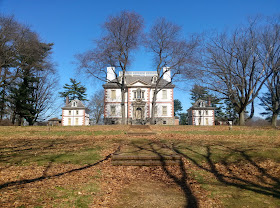 |
| Trail-testing the Black Diamond ReVolt rechargeable headlamp |
 |
| Testing the Black Diamond ReVolt at Pinnacle Rock, Rock Creek Park |
"Oh, cool!", I thought, as I took a moment to attempt to snap a photograph of this magnificent nocturnal creature not 15 feet away from me. But just as I had my phone camera trained on the owl, it turned its head around like a horror movie doll and stared directly at me, its eyes aglow in the headlamp's beam. The owl's glare was long enough to send chills down my spine. Then it twisted its head mechanically back around to watch the creek.
I clumsily shoved my phone back in my pocket, deciding I should probably move along and get back to my car before things got weird. This owl was obviously on the hunt.
 |
| Heading down the trail near Pinnacle Rock, as darkness takes over the forest |
Just like that, the talons of the great barred owl attempted to snatch onto my bald head, knocking me forward on the precariously narrow bluffs trail. Then, as quickly as it had attacked, the owl disappeared again, silently slipping away somewhere into the hushed calm of the urban forest.
I didn't stop to figure out where it had gone, or to see if it was still somewhere close and ready to attack again. I just assumed it would if I stood still. So instead, I took off my backpack and began to swing it around my head as I carefully sprinted down the dark trail, relying only on my Black Diamond ReVolt headlamp to guide me safely to the trailhead.
 |
| Descending the Roosevelt Trail, moments before the owl attack |
The dark figure disappeared, and I kept flailing and making a bit of noise as I carefully but quickly hopped rocks and roots along the Roosevelt Trail with one goal in mind - reaching the safety of my car, parked across the creek along Broad Branch Road.
When I made it down to Beach Drive, several cars were passing by, though no runners or bikers were anywhere to be found. Maybe they knew something I didn't about the kinds of animalistic activities that go on in Rock Creek Park after the sun goes down. In any case, I darted to my car, jumped inside and began to drive.
As I navigated my way back across town to Park View, I felt a stinging sensation in the back of my head. I reached around, and it stung even more under the touch of my salty hands. I knew I'd been scratched at the least. But it was too dark in the car to tell if I was bleeding. When I got home, I realized that I was in fact bleeding, but only slightly. So I administered first aid, took a few photos of the back of my head to see what the talon marks looked like, and decided to go online and research owl attacks, since before tonight I can't say I recall ever hearing that owls attack humans.
 |
| Talon marks from the barred owl that attacked me (with Remy photobomb) |
According to the Washington Post article, on occasion, people have been known to come across a baby owl before it can fly and, believing it to be abandoned by its mother, they "rescue" it. As a result of such novice intervention, Global Owl Project Director David Johnson said, "rescued" owls soon grow too big to be cared for by novices, and so these ignorant do-gooders release the now domesticated owl back into the wild where they lack the skills to hunt and survive on their own. Not knowing how to hunt, the owl then mistakenly turns on humans, the only animal it grew up having any knowledge of.
So there you have it! I was attacked by a barred owl in Rock Creek Park, and I learned a few things as a result. The most salient lesson of all is that if you are going to be hiking at night, you need a quality headlamp that will not only show you the way but be able to help you respond quickly should an unexpected emergency arise. Now, I haven't trail tested any other headlamps, but I can tell you that the ease of use of the Black Diamond ReVolt headlamp - notably the ease at which I was able to redirect the beam while being chased by an angry owl down a narrow bluffs trail - made me extremely happy with my purchase.
Brian Schwarz is a freelance writer and outdoor leader based in Washington, D.C. He often leads hikes in Rock Creek Park and the surrounding areas, which are posted on the Facebook page Hiking Megalopolis. Contact Brian via the comment section below, and for links to his social media activity, refer to his splash page at about.me/brian.schwarz.






